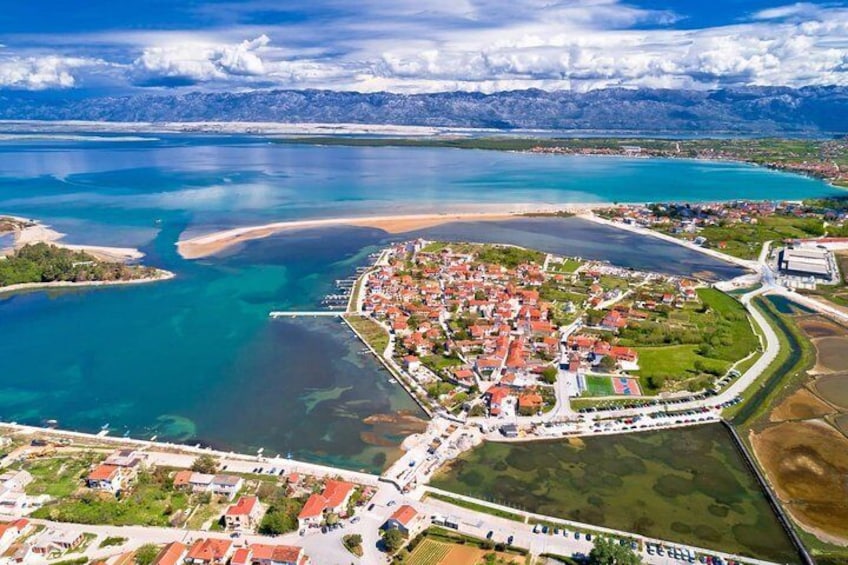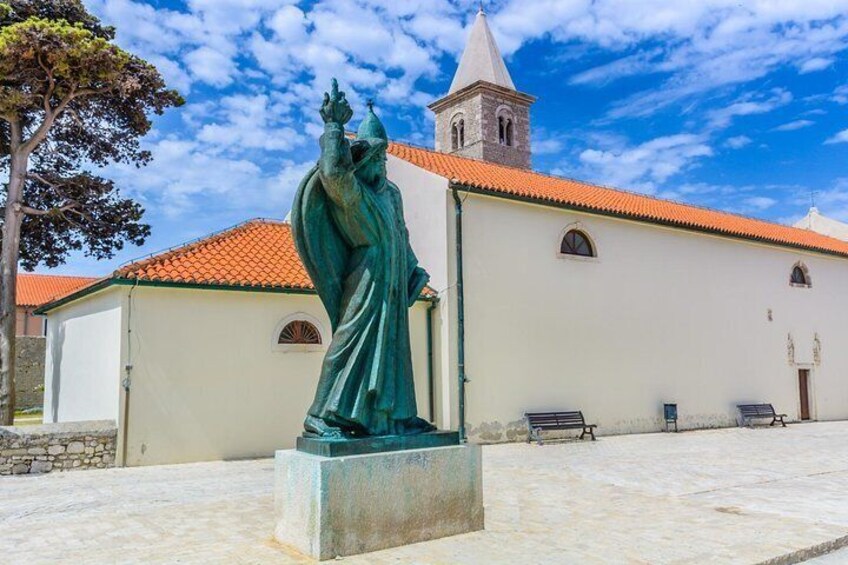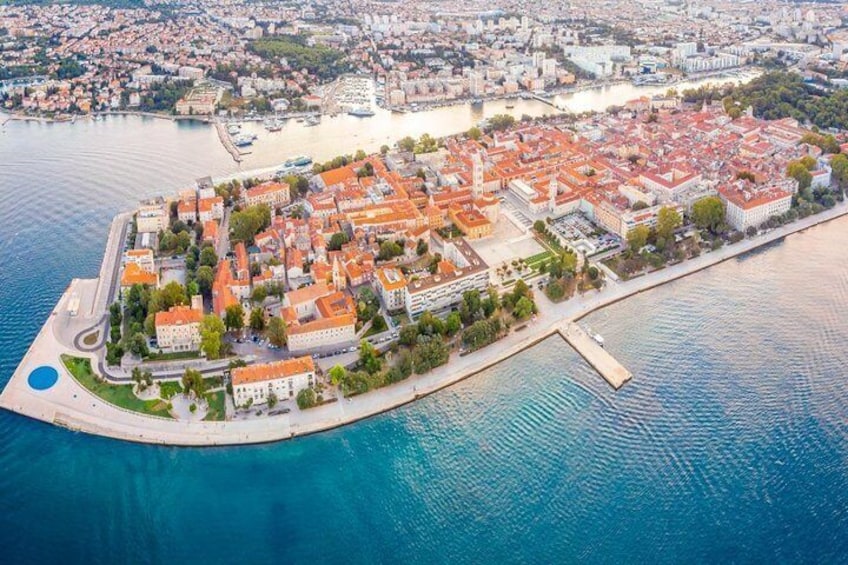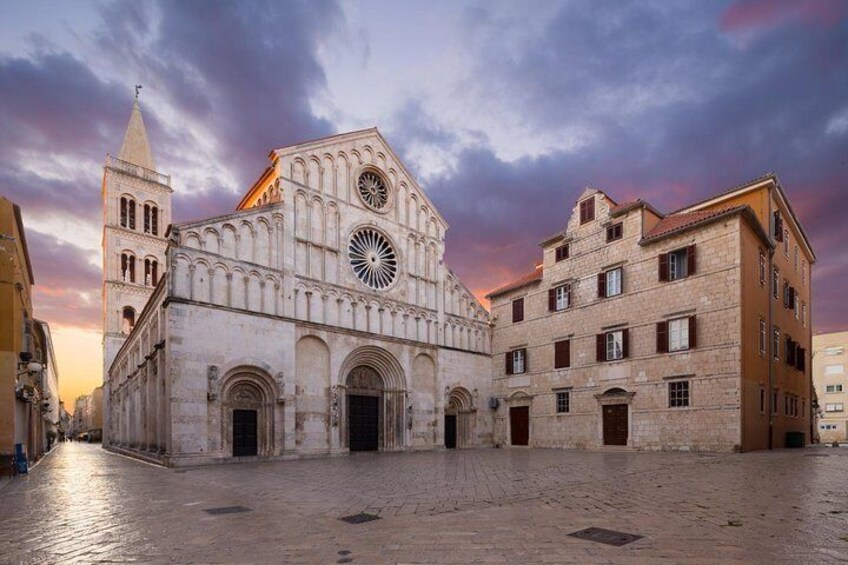




Day trip to Nin and Zadar
By Dabi Abu
10/10
10 out of 10Free cancellation available
per adult*
*Get lower prices by selecting more than 2 adults
Features
- Free cancellation available
- 13h
- Mobile voucher
- Instant confirmation
- Selective hotel pickup
Overview
At 8am we will leave Zagreb and in just 3 hours drive by car we will visit world attractions and the most popular and beautiful places Croatia has to offer.
The beautiful City of Zadar and Nin, the smaller town with even greater soul and historical significance.
In Nin we will visit a salt factory, the smallest church in the world and one of the most beautiful beaches in the world, Queen's Beach with healing mud.
After visiting all the beauties of the town of Nin, in only 30 minutes drive by car we arrive to Zadar.
We will walk through Kalelarga street, visit greetings to the sun and sea organ, St. Donatus Church and St. Anastasia Cathedral and discover hidden gems this city has to offer.
Activity location
- Nin
- Nin, Croatia
Meeting/Redemption Point
- Nin
- Nin, Croatia
Check availability
Day trip to Nin and Zadar
- 13h
- English
Pickup included
Language options: English
Starting time: 8:00 am
Price details
AU$659.38 x 1 AdultAU$659.38
Total
*Get lower prices by selecting more than 2 adults
What's included, what's not
- Private transport
- Air-conditioned vehicle
- All Fees and Taxes
- Lunch
Know before you book
- Service animals allowed
- Public transport options are available nearby
- Suitable for all physical fitness levels
Activity itinerary
Nin
- 3h
Nin, a small town in Zadar County, is located in a unique lagoon on the Croatian Adriatic coast. There is an oasis of sandy beaches in the middle of the Bay of Nin, especially highlighting one of the most beautiful beaches in the world, the Queen's Beach. To the east are the Solane Nin fields, and to the west is a healing mud site that has been used for healing and rehabilitation for 40 years. The Blue Flag is a proof and symbol of the extremely clear sea where endemic species of plants and animals live.
An exciting past and a wonderful present
On a small island in the middle of a shallow lagoon is the old town core of the small town of Nin, connected by land to two stone bridges. Nin has an exciting past and a wonderful present. All his stories and monuments, all his beauty and natural resources are here for you to enjoy and find the much needed joy, health and spiritual pleasure.
Nature and man made it a pleasant holiday town, interesting for its rich historical heritage and great for health. It is the oldest Croatian royal city, the cradle of the Croatian state. It houses the smallest cathedral in the world and the coronation church of St. Nicholas. And one of the most beautiful beaches in the world. Nin has a rich cultural treasury and preserved nature and an extremely beautiful environment.
It is a European destination of excellence. It has healing mud that reliably cures many ailments. There is also a salt works where production is here before your eyes, and today it is based on a millennial tradition. If you touch the thumb of the statue of Gregory of Ninsky - the legend says - you have secured your happiness. Moreover, one foreign portal has made it one of the world's ten most attractive symbols of happiness. It's worth convincing!
Nin also has thousands of stories, the most famous campsite in Croatia within the modern and rich tourist resort Zaton Holiday Resort and a contemporary offer, which receives many international and Croatian accolades from year to year due to its superior quality, decor and amenities.
Nin and its surroundings are a fantastic source of experience, active holidays and the present intertwined with a history whose rich and extremely valuable treasury is always open to you. And every new day is more beautiful and tidy than yesterday.
Quite simply, Nin has everything you want and need, but it - reliably - gives you more than you expected. He is a small town you may have come to first by chance. Each new arrival is a meeting of friends who share the same values.
Nin is a special place. A storey that lasts. And a lifetime of joy that never ceases. Welcome!
Solana Nin - Salt Museum
- 1h 30m
- Admission ticket included
Museum and Salt House
Between 70,000 and 100,000 people visit Solana Nin annually. The whole of Solana is a magical museum. It is over 1500 years old. This is evidenced by archaeological findings from the Liburno (Illyrian) period, then the Roman prison, the Velebit storm, healing mud, over 200 bird species, old tools. Solana tells the storey of salt throughout history, wars, celebrations, love, pleasure and work. Much has changed throughout this time, but one thing has remained the same. Salt is still handmade, just as it used to be, with a great dose of love and pleasure, and for generations the fields of Nin salts have been given the best of the sun, the Adriatic Sea and the Velebit storm.
Within the salt pans are a museum and a salt house. Here you can step into the past through the display of black and white photographs from the distant past, old tools, wagons used long ago as a means of transporting salt from the pool to storage, but at the same time navigate the present through interactive play and a mock-up of a unique nature reserve. and documentary in Croatian, German and English.
So dive into the enchanting museum of the only ecological salt pans in the Adriatic Sea that will delight you with words, pictures and deeds and teach you about the difficult, but most valuable, things we keep for future generations ... Immerse yourself in our storey of salt.
St. Nicholas Church
- 15m
- Admission ticket included
Church of St. Nicholas
The most recognisable symbol of city Nin is the church of Sv. Nicholas located in the Prahulja field. It is very important for rulers from the Croatian dynasty and for Nin and Croatian history. In Nin, according to the folk tradition, seven kings were crowned, and each crowned ruler rode to the church of St. Nicholas, and this is where he introduced himself to the people with always the same symbolic ritual - he would cut the sword from that mound on all four sides of the world.
The church is built on an earthen mound that rises above a vast field and this is where you can experience unforgettable sunsets. There are still unexplored prehistoric graves in the mound. The church is 5.90 m long, 5.70 m wide, 6 m high (internal measures), while the walls are 50 cm thick. Due to the danger of the Turks, a defensive crown with 8 teeth was added to the church in the 16th - 17th centuries, which served as a scout. The Church of St. Nikola is the only preserved example of early Romanesque architecture of this form in Dalmatia, dating from the late 11th and early 12th centuries.
Zadar
- 3h
ZADAR
For centuries, the capital of Dalmatia, and today the centre of the region, is a city with a rich monumental heritage of world significance, which is still visible at every turn: Roman Forum from the 1st century, Church of St. Donatus from the 9th century - the most famous medieval basilica, the trademark of the city, the restored Romanesque church of St. Baptism from the 12th c. Of Mary, 1105, Cathedral of Sts. Anastasia from the 13th century, Narodni trg with the Town Lodge and Guard from the 16th century and powerful ramparts with representative Port and Land gates from the 16th century, then Square 3 wells and Square 5 wells and numerous palaces, villas and other monuments inheritance. The city of Zadar is not only famous for its cultural and historical monuments, but also for its always rich green market and fish market on the peninsula (the old part of town). From the rich hinterland of Ravni kotari, the fertile areas around Lake Vrana and the islands of Ugljan and Pašman, the Zadar market is stocked daily with fresh vegetables and fruits. Its attractiveness can also be attributed to its natural location in the heart of the Adriatic coast, surrounded by 4 National Parks: Plitvice Lakes, Paklenica Mountain Park, unique waterfalls of the Krka River and a number of beautiful Kornati islands. No less attractive are nature parks: Telascica, the canyon of the Karst river Zrmanja, and the largest natural lake in Croatia - Lake Vrana near Biograd.
Church of St. Donat
- 20m
- Admission ticket included
Church of St. Donat
Church of St. Donat is a symbol of the city of Zadar and the most famous monumental building in Croatia from the early Middle Ages (9th century).
Church of St. Donat is a round pre-Romanesque church which until the 15th century was called the church of St. Trinity, and has since been named St. Donat, after the bishop who had built it. The church was first mentioned in the mid-10th century in the writings of the Byzantine emperor Constantine Porphyrogenitus.
Due to its distinctive cylindrical shape and somewhat robust monumentality, this building belongs to the most famous and significant pre-Romanesque churches in Europe. The type of construction follows the shape of the court churches of the circular layout from the early Byzantine to the Carolingian period. However, in its rough monumentality (27 metres high), unusual cylindrical shape and double internal space, it stands out for its originality, without some direct role models.
Much of the architectural decoration, as well as the monolithic pillars in the church, are of ancient origin and originate mainly from the demolished Roman Forum. When the foundations of the building were stripped bare for research, a whole series of Roman pillars appeared, on which the church building rests, built directly on the remains of the forum.
Today, because of its exceptional acoustic characteristics, its space is used for various music programmes ("Musical Evenings in St. Donat").
Zadar Cathedral
- 20m
- Admission ticket included
the cathedral of st. Anastasia
Zadar Cathedral of Sv. Stosije (Anastazije) is a three-nave Romanesque building, also the largest church in Dalmatia. It was built on two occasions, in the 12th and 13th centuries, with the preserved elder from the 9th and 11th centuries, erected on the site of an early Christian basilica. The beginnings of the construction of the Zadar Cathedral go back to the 4th or 5th century.
Sea Organ (Morske Orgulje)
- 30m
- Admission ticket included
Sea organ
Sea organs are located on the western part of the Zadar waterfront and are recognisable for their cascading coastal profile that stimulates change in coastal movement, retention and descent to the sea.
The stone steps extend to seventy metres of the coast, divided into seven ten-meter sections, below which, at the level of the lowest sea level, 35 polyethylene pipes of various lengths, diameters and slopes are installed perpendicularly to the shore, rising obliquely to the coastal position and ending in the channel. (service corridor). The wave-suppressed air is led from a broader to a narrower profile, in order to obtain acceleration and produce sound in the instruments (LABIUMI - whistles) located in the corridor below the coastal promenade, from where the sound (through mystical openings in stone) exits into the space of the promenade. The instrument has seven clusters of five selected tones derived from the matrix of Dalmatian singing. Just as the energy of the sea is unpredictable in innumerable changes of tide, low tide, size, power and direction, so is the eternal concert of marine organs inimitable in innumerable musical variations, whose author and interpreter is nature itself
This is a place where the combination of human ideas and skills with the energy of the sea, waves, low tide and tide, a place for relaxation, reflection and conversation with a continuous concert of the mystical tones of the "orchestra of Nature".
Immediately after the completion of the construction, the Sea Organs were promoted to the metaphorical place of the city of Zadar, which is now excited by its citizens, which has become an unavoidable point in all the tourist itineraries of the city of Zadar and its region.
The marine organ was designed by architect Nikola Bašić from Zadar with the help of a number of experts: the consultant for marine hydraulics was prof. Vladimir Androšec from the Zagreb Faculty of Civil Engineering, pipes were performed by Goran Ježina from Murter, and the well-known art workshop for organ making - Heferer from Zagreb made 35 labiums for each tube, and their musical tuning was performed by prof. Ivica Stamac from Zagreb.
Location
Activity location
- Nin
- Nin, Croatia
Meeting/Redemption Point
- Nin
- Nin, Croatia
Best Deals on Things to Do
Experience the wonders of the world up close with great deals on things to do near and far. We offer one-of-a-kind activities that allow you to explore Nin your way. Whether you love nature, culture, food or a bit of adventure, we have the perfect activity for you.